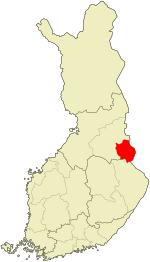Kuhmo
| Kuhmo | ||
|---|---|---|
| Town | ||
| Kuhmon kaupunki | ||

The Town hall
|
||
|
||
 |
||
| Coordinates: 64°07.5′N 029°31′E / 64.1250°N 29.517°ECoordinates: 64°07.5′N 029°31′E / 64.1250°N 29.517°E | ||
| Country |
|
|
| Region | Kainuu | |
| Sub-region | Kehys-Kainuu sub-region | |
| Charter | 1865 | |
| City rights | 1986 | |
| Government | ||
| • Town Manager | Eila Valtanen | |
| Area (2016-01-01) | ||
| • Total | 4,806.31 km2 (1,855.73 sq mi) | |
| • Land | 4,806.85 km2 (1,855.94 sq mi) | |
| • Water | 649.97 km2 (250.95 sq mi) | |
| Area rank | 12th largest in Finland | |
| Population (2016-03-31) | ||
| • Total | 8,755 | |
| • Rank | 115th largest in Finland | |
| • Density | 1.82/km2 (4.7/sq mi) | |
| Population by native language | ||
| • Finnish | 98.3% (official) | |
| • Swedish | 0.1% | |
| • Others | 1.6% | |
| Population by age | ||
| • 0 to 14 | 13.1% | |
| • 15 to 64 | 63.5% | |
| • 65 or older | 23.5% | |
| Time zone | EET (UTC+2) | |
| • Summer (DST) | EEST (UTC+3) | |
| Municipal tax rate | 20.25% | |
| Website | www.kuhmo.fi | |
Kuhmo is a town and a municipality in Finland and is located at the south-eastern corner of the Kainuu region. The municipality has a population of 8,755 (31 March 2016) and covers an area of 4,806.31 square kilometres (1,855.73 sq mi) of which 649.97 km2 (250.95 sq mi) is water. The population density is 1.82 inhabitants per square kilometre (4.7/sq mi). It has a borderline of 120 kilometres (75 mi) with Russia. Neighbour towns are Hyrynsalmi, Lieksa, Nurmes, Ristijärvi, Sotkamo and Suomussalmi. Neighbour city across the Russian border is Kostomuksha. Vartius, one of the border crossing points between Finland and Russia, is located in northern Kuhmo
Kuhmo´s eastern border is located at a drainage divider and town area belongs to drainage basin of Oulujärvi.
The municipality is unilingually Finnish.
First inhabitants arrived to Kuhmo after last ice-age, around 8000 BC. Proof of stone age habitation has been found around Ontojärvi and Lammasjärvi. Sami people habitated Kuhmo area until migration from Karelia and Savonia pushed Sami people up north. Influence of Sami culture is still found in the placenames. Wide spreading water routes are known to have attracted hunters, raiders, merchants and tax collectors since 9th century
...
Wikipedia

